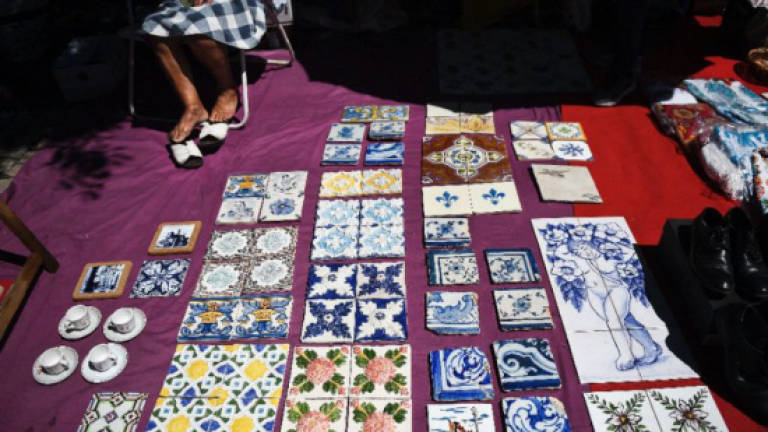Thieves target historic Portuguese decorative tiles

LISBON: Gaping holes on the crumbling walls of an abandoned palace in the heart of Lisbon mark where decorative ceramic tiles have been yanked off, to the displeasure of passing tourists.
Thieves are swiping the elaborately painted tiles, which cover buildings across Portugal, to sell them on the black market. Just one of these tiles, called azulejos, can fetch thousands of euros.
And abandoned buildings like the 17th century Pombal Palace, are especially vulnerable.
This was once the family home of the Marquis de Pombal, the statesman who rebuilt Lisbon after a massive earthquake devastated the city in 1755.
Owned by Lisbon's cash-strapped city hall for the last five decades, it has fallen into ruin due to lack of maintenance.
And since a cultural association, Carpe Diem, moved out at the end of July, the palace has been empty.
"SOS Azulejo", a project set up by police in 2007 to stop antique dealers from selling stolen Portuguese tiles, includes it on its list of "high risk" buildings.
Tile thefts have plunged by 80% since the project was set up, said Leonor Sa, the head of Portugal's police museum which displays recovered stolen tiles.
But a huge amount of thefts go unreported, she added.
"The Portuguese do not file complaints because for them they are the most banal thing in the world. They live surrounded by tiles since their birth until their death," Sa told AFP.
"Foreign tourists who discover these ceramics love them because they don't have them at home."
Sa, who has a doctorate in cultural studies, gave birth to her two daughters, Rita and Joana, at a Lisbon hospital decorated in azulejos, where she herself was born 59 years ago.
Churches pillaged
Azulejos first came to Portugal in the early middle ages when Portugal was under Moorish rule.
Although many assume the word is a derivation of azul – Portuguese for "blue", the colour of most tiles – the word is Arabic in origin and comes from az-zulayj, which roughly translates as "polished stone".
Disgusted at the loss of this unique Portuguese treasure, Sa set up an internet site, www.sosazulejo.com, that displays photos of tiles stolen from churches, hospitals, train stations and other buildings.
It makes it easy to check if a tile on sale at a street market or antique dealer was stolen.
"It's very dissuasive," said Sa, who is full of energy and has an intense gaze.
Tile thefts reached peaks of around 10,000 per year in 2001, 2002 and 2006 but "now there are significantly fewer" thefts, she said.
Since 2013 it is illegal in Lisbon to demolish a facade decorated with tiles without the authorisation of city officials. Parliament plans to extend the rule to the entire country shortly.
At Lisbon's rambling Feira da Ladra flea market, or "Thieves' Market", old azulejos are on sale for between five euros and 100 euros (US$118, RM505).
A giant 18th-century panel made up of brown, gold and green tiles depicting exotic animals and flowers was on sale for 500 euros.
Prices at antique dealers can go even higher, with some azulejos fetching up to 10,000 euros.
'I don't steal'
Anne Typhagne, a 43-year-old French tour guide, lingers before a display of tiles at the flea market which overlooks the Tagus river.
"Before I bought a lot of them, then I stopped because I am against the theft of Portugal's heritage," she said.
Police inspections of tile vendors at the market are frequent.
"When they come, I show all the papers. I sell, I don't steal," said Maria Santos, 28, whose small stand teems with ceramic tiles from the 18th and 19th centuries.
While some tiles are recovered from building demolitions, Santos said "often, we don't really know where they come from".
Oscar Pinto, the head of the national police division dedicated to crimes involving art, said the majority of tiles that are sold have a "legitimate" origin.
"Sometimes it is the landlords themselves that get rid of them to renovate their homes," he said at his sparsely decorated office.
"But lets not kid ourselves. A drug addict who sells you 20 azulejos in a plastic bag at one euro a piece, there is a strong chance that it was a theft."
Pinto had gone to the flea market the day before to try, in vain, to recover over one thousand 18th-century ceramic tiles pulled down overnight from an abandoned building in Lisbon's riverside Baixa district.
The Portuguese capital's tourism boom "could contribute to an upsurge in thefts", he said.
Ceramics maker Cristina Pina, 55, thinks she has found a solution to stop tourists from buying old tiles – she has set up a small shop near the market that sells reproductions of azulejos made in the 18th century.
"I prefer it if tourists buy beautiful reproductions of azulejos as souvenirs of Lisbon, which will allow the originals to remain in the country," she said. — AFP